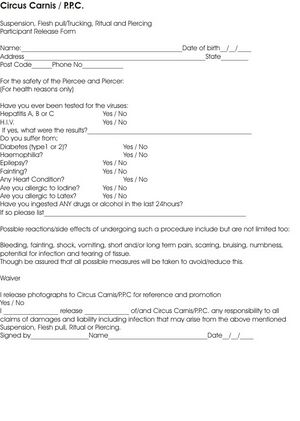Consent and Consent Form: Difference between pages
(Difference between pages)
Jump to navigation
Jump to search
(Page conversion via llm-mediawiki-rev -jwm) |
(Page conversion via llm-mediawiki-rev -jwm) |
||
| Line 1: | Line 1: | ||
[[File:Release.jpg|thumb|right|Basic template of the Circus Carnis consent form]] | |||
A '''consent form''' is a document which acknowledges that the client who is receiving the procedure gives [[Consent|consent]], is of full understanding and accepts the risk of undergoing and healing a particular [[Piercing|piercing]], [[Tattoo|tattoo]], [[Body modification|body modification]] or [[Ritual|ritual]]. | |||
Latest revision as of 01:58, 17 September 2023
A consent form is a document which acknowledges that the client who is receiving the procedure gives consent, is of full understanding and accepts the risk of undergoing and healing a particular piercing, tattoo, body modification or ritual.
